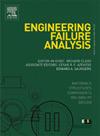混合润滑条件下齿面点蚀对动态特性的影响
IF 5.7
2区 工程技术
Q1 ENGINEERING, MECHANICAL
引用次数: 0
摘要
齿面点蚀引起的齿面啮合刚度和摩擦特性的变化会增加齿轮传动系统的振动和噪音。在研究齿轮接触和动力学时,假设齿面光滑且材料均匀,不足以揭示点蚀故障引起的动态接触性能的演变。在本研究中,我们建立了点蚀故障耦合分析模型,以评估齿面微观形态的影响。计算了随机分布点蚀的齿轮的啮合刚度和静态传动误差,并解析了不同点蚀程度齿轮的振动响应。最后,利用构建的点蚀故障模拟试验台对所应用的动态响应理论分析的有效性进行了实验验证。结果表明,点蚀故障降低了齿轮轮齿的有效承载能力。啮合刚度随着点蚀程度的增加而逐渐减小,但减小的幅度很大,而且其值也有波动。点蚀故障在齿轮传动系统的振动响应中诱发了明显的周期性特征,在啮合频率及其谐波周围显示出复杂的边带。本文章由计算机程序翻译,如有差异,请以英文原文为准。
Effect of tooth surface pitting on dynamic characteristics under mixed lubrication
The variation of tooth meshing stiffness and frictional characteristics caused by tooth surface pitting increases vibration and noise in the gear transmission system. Assuming a smooth tooth surface and a homogeneous material in studying the gear contact and dynamics is insufficient to reveal the evolution of dynamic contact performance caused by pitting faults. In the present study, we established a coupling analysis model for pitting faults to assess the effect of the tooth surface micro-morphology. The mesh stiffness and static transmission error of gears with randomly distributed pittings were calculated, and the vibration response of gears with different pitting degrees was resolved. Finally, the effectiveness of the applied dynamic response theory analysis was experimentally verified using the constructed pitting fault simulation test bench. The results indicate that pitting failure decreases the effective load-bearing capacity of gear teeth. The mesh stiffness gradually but significantly decreased with the pitting degree, also exhibiting fluctuating values. Pitting faults induced significant periodic features in the vibration response of gear transmission systems, showing complex sidebands around the meshing frequency and its harmonics.
求助全文
通过发布文献求助,成功后即可免费获取论文全文。
去求助
来源期刊

Engineering Failure Analysis
工程技术-材料科学:表征与测试
CiteScore
7.70
自引率
20.00%
发文量
956
审稿时长
47 days
期刊介绍:
Engineering Failure Analysis publishes research papers describing the analysis of engineering failures and related studies.
Papers relating to the structure, properties and behaviour of engineering materials are encouraged, particularly those which also involve the detailed application of materials parameters to problems in engineering structures, components and design. In addition to the area of materials engineering, the interacting fields of mechanical, manufacturing, aeronautical, civil, chemical, corrosion and design engineering are considered relevant. Activity should be directed at analysing engineering failures and carrying out research to help reduce the incidences of failures and to extend the operating horizons of engineering materials.
Emphasis is placed on the mechanical properties of materials and their behaviour when influenced by structure, process and environment. Metallic, polymeric, ceramic and natural materials are all included and the application of these materials to real engineering situations should be emphasised. The use of a case-study based approach is also encouraged.
Engineering Failure Analysis provides essential reference material and critical feedback into the design process thereby contributing to the prevention of engineering failures in the future. All submissions will be subject to peer review from leading experts in the field.
 求助内容:
求助内容: 应助结果提醒方式:
应助结果提醒方式:


